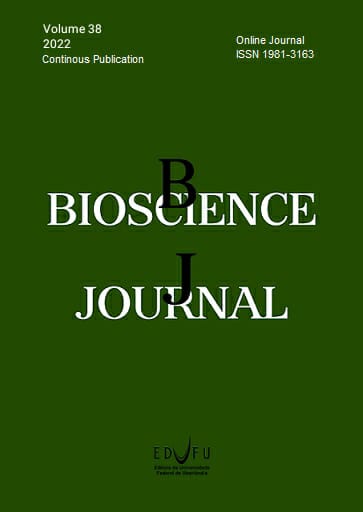Effect of different herbicides on Bidens pilosa and Euphorbia heterophylla biotypes resistant to ALS inhibitors
DOI:
https://doi.org/10.14393/BJ-v38n0a2022-53823Keywords:
Acetolactate Synthase, Blackjack, Resistance, Wild Poinsettia.Abstract
Select herbicides with different mechanism of action is a satisfactory option for resistant weed control. Then, the present work aimed to study the efficiency of different herbicides and their mixtures on Bidens pilosa (blackjack) and Euphorbia heterophylla (wild poinsettia) biotypes, resistant to ALS herbicides in two development stages. The trials we arranged in a completely randomized design with four replications. The treatments tested were (g a.i/a.e ha-1): imazethapyr at 70 and 140 (WG formulation) + 1.0% Assist; imazethapyr at 57.6 and 72 (SL formulation) + 1.0% Assist; imazapic + imazethapyr at 56 and 70 + 1.0% Assist; glyphosate + imazethapyr (596); saflufenacil + glyphosate at 35 + 720 + 0.5% Dash in tank mix, glyphosate at 720 and, a control without herbicide application. Control efficiency was evaluated, as well as dry matter accumulation at the end of the studies. Plants of both species were more susceptible to herbicides at the early stage of development (2 to 4 leaves). The treatments with saflufenacil + glyphosate, (imazethapyr + glyphosate) and glyphosate promoted the best controls, regardless of the species studied and the application stage. The mixture with saflufenacil provided the highest control speed, and the mixture (imazethapyr + glyphosate) was less efficient among three excellent treatments when applied to plants in the 4-6 leaf stage. The treatments (imazethapyr, in both formulations) and (imazethapyr + imazapic) were ineffective in controlling the studied biotypes, regardless of dose and developmental stage studied.
References
AARESTRUP, J.R., KARAM, D., FERNANDES, G.W. and CORRÊA, E.J.A. Efeito do herbicida chlorimuron-ethyl em biótipos resistente e suscetível de Euphorbia heterophylla. Planta daninha. 2008, 26(4), 911-916. https://doi.org/10.1590/S0100-83582008000400023
ALISTER, C. and KOGAN, M. Efficacy of imidazolinone herbicides applied to imidazolinone resistant maize and their carryover effect on rotational crops. Crop Protection. 2005, 24(4), 375–379. https://doi.org/10.1016/j.cropro.2004.09.011
BRAZ, G., et al. Herbicidas alternativos no controle de Bidens pilosa e Euphorbia heterophylla resistentes a inibidores de ALS na cultura do algodão. Revista Brasileira de Herbicidas. 2011, 10(2), 74-85. https://doi.org/10.7824/rbh.v10i2.101
BONOW, J.F.L., et al. Resistance of Echinochloa var. mitis to imazapyr+imazapic herbicide and alternative control in irrigated rice. Planta Daninha. 2018, 36, e018168627. https://doi.org/10.1590/s0100-83582018360100028
BURGOS, N.R., et al. Review: confirmation of resistance to herbicides and evaluation of resistance levels. Weed Science. 2013, 61, 4-20. https://doi.org/10.1614/WS-D-12-00032.1
CHIAPINOTTO, D.M., et al. P.Cross-resistance of rice flatsedge to als-inhibiting herbicides. Planta Daninha. 2017, 35, e017166827. https://doi.org/10.1590/s0100-83582017350100068
CHRISTOFFOLETI, P.J. and NICOLAI, M. Aspectos de resistência de plantas daninhas a herbicidas. 4th ed. Piracicaba: Associação Brasileira de Ação a Resistência de Plantas aos Herbicidas. 2016.
FRANCISCHINI, A., et al. Multiple-and cross-resistance of Amaranthus retroflexus to acetolactate synthase (ALS) and photosystem II (PSII) inhibiting herbicides in preemergence. Planta Daninha. 2019, 37, e019179353. https://doi.org/10.1590/s0100-83582019370100026
HEAP, I. The International Survey of Herbicide Resistant Weeds. 2019. Available from: www.weedscience.org
MONQUEIRO, P.A., CHRISTOFFOLETI, P.J. and DIAS, C.T.S. Resistência de plantas daninhas aos herbicidas inibidores da ALS na cultura da soja (Glycine max). Planta Daninha. 2000, 18(3), 419-425. https://doi.org/10.1590/S0100-83582000000300005
NTOANIDOU, S., et al. Molecular basis of Cyperus difformis cross-resistance to ALS-inhibiting herbicides. Pesticide Biochem Physiology. 2016, 127, 38-45. https://doi.org/10.1016/j.pestbp.2015.09.004
OLIVEIRA NETO, M., et al. Estratégias de manejo de inverno e verão visando ao controle de Conyza bonariensis e Bidens pilosa. Planta Daninha. 2010, 28(4), 1107-1116. https://doi.org/10.1590/S0100-83582010000500018
POWLES, S.B. and YU, Q. Evolution in action: Plants resistant to herbicides. Annual Review of Plant Biology. 2010, 61(4), 317-347. https://doi.org/10.1146/annurev-arplant-042809-112119
SBCPD - SOCIEDADE BRASILEIRA DA CIÊNCIA DAS PLANTAS DANINHAS. Procedimentos para instalação, avaliação e análise de experimentos com herbicidas. 1st ed. Londrina: SBCPD, 1995.
ULGUIM, A.R., et al. Resistance mapping of the genus Cyperus in Rio Grande do Sul and selection pressure analysis. Planta Daninha. 2019, 37, e019186679. https://doi.org/10.1590/s0100-83582019370100062
VARGAS, L., et al. Práticas de manejo e a resistência de Euphorbia heterophylla aos inibidores da ALS e tolerância ao glyphosate no Rio Grande do Sul. Planta Daninha. 2013, 31(2), 427-432. https://doi.org/10.1590/S0100-83582013000200021
TAKANO, H.K., et al. Multiple resistance to atrazine and imazethapyr in hairy beggarticks (Bidens pilosa). Ciência e Agrotecnologia. 2016, 40(5), 547-554. https://doi.org/10.1590/1413-70542016405022316
TREZZI, M.M., et al. Características morfofisiológicas de biótipos de Euphorbia heterophylla com resistência a diferentes mecanismos de ação herbicida. Planta Daninha. 2009, 27, 1075-1082. https://doi.org/10.1590/S0100-83582009000500021
Downloads
Published
Issue
Section
License
Copyright (c) 2022 Maria Renata Rocha Pereira, Sidnei Roberto de Marchi, Dagoberto Martins

This work is licensed under a Creative Commons Attribution 4.0 International License.





